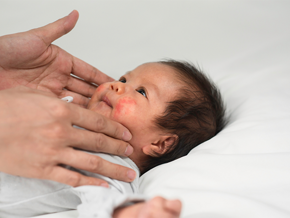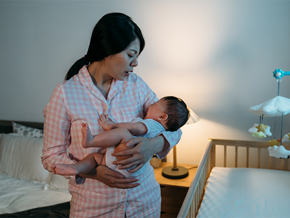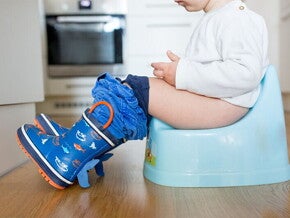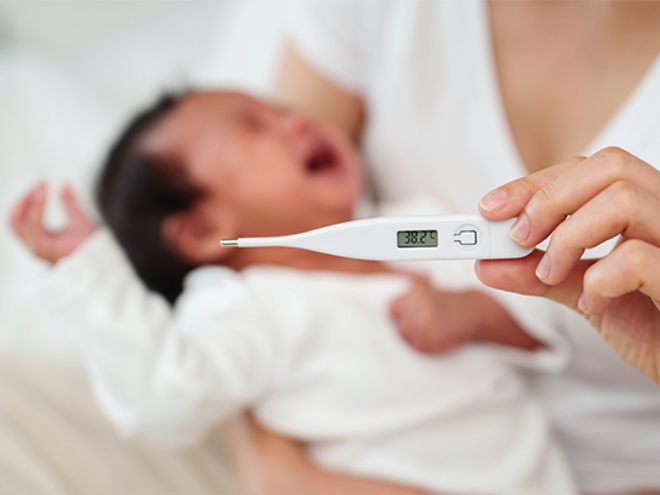
Your baby feels warm, their cheeks are flushed, and you’re panicking. We get it because baby fever feels scary, especially when you’re a first-time mom. But not every rise in temperature is a reason to rush to the ER.
Learn the most common causes of fever in babies, how to soothe your little one, and when to call the doctor
What Causes Fever in Babies?
There are many reasons your little one might be feeling hot, and most of them are manageable. Here are the common culprits of fever:
Viral infections
Think colds, flu, roseola or even tummy bugs. According to the MSD Manual Professional Edition, viral respiratory or gastrointestinal infections are the most common cause of fever in infants and young children.
Bacterial infections
While less common than viruses, bacterial infections can be more serious. Bacterial culprits like ear infections, pneumonia, upper respiratory tract infections, and urinary tract infections often require antibiotics, so it’s best to get medical advice if symptoms worsen or persist.
Post-vaccination fever
If your little one just got their shots, they may get a low-grade fever, a common, short-lived side effect of routine immunizations. A 2019 study in the Journal of Medical Internet Research, which involved South Korean children, revealed that post-vaccination fever behaved differently depending on the type of vaccine and whether fever-reducing medications were used.
For instance, fevers connected to the influenza vaccine tended to last longer, while those related to the pneumonia vaccine were generally shorter.
Interestingly, the study showed that children who didn't take fever reducers experienced a quicker recovery and shorter duration of their fever (about 9.9 and 10.1 hours less, respectively).
Baby teething fever
While teething doesn’t directly cause high fever, it can slightly raise your baby’s temperature and make them fussier. In a ParenTeam article on teething, Dr. Frances Esguerra agrees that if the fever is mild (under 38°C or 100.4°F) and your baby is drooling and chewing on everything, teething might be the cause.
Inflammatory or auto-immune conditions
Conditions like Kawasaki disease or juvenile arthritis can cause fever. These are rare, but it’s good to be aware, especially if fever lingers without other signs of infection.
Heat-related causes
Over-dressing or too much time in the sun can make your baby feel hot. This isn’t technically a fever from infection, but it can still cause overheating and can be addressed quickly.
Reaction to medications
Some antibiotics or supplements may cause a mild fever as a side effect. If you’ve recently introduced new meds, mention this to your doctor.
Mosquito-borne diseases
Living in the tropics makes babies susceptible to conditions like malaria or dengue, which can cause fever. The Philippine Society for Microbiology and Infectious Diseases reminds parents to be aware and practice the Department of Health’s 4-S strategy, especially during rainy season.
How to Tell Your Baby Has a Fever
Not sure if your baby has a fever? These signs may help you spot it, according to the American Academy of Pediatrics (AAP):
- Warm skin (especially on forehead, back, or belly)
- Elevated body temperature
- Flushed or rosy cheeks
- Shivering or trembling
- Fussiness or irritability
- Sleepier than usual or harder to wake
- Feeding less or refusing milk
- Less interested in playing
- Frequent crying or difficult to soothe
- Feeling clammy or sweaty
- Fewer wet diapers
- High-pitched or weak cry
- Complaining of aches (in toddlers)
- Rapid breathing or fast heartbeat
Fever is a sign of a disease, usually an infection. If it is accompanied by symptoms like rashes, rapid breathing, a fast heartbeat, or seizures, it points to a more serious condition.
For example, febrile seizures can happen when a child’s body temperature rises quickly, while a rash may signal an infection like dengue or roseola. If your baby shows any of these signs, consult your pediatrician promptly.
Which Baby Fever Temperature Is a Cause for Worry?
What counts as a fever for babies depends on their age. Here’s a quick breakdown from the AAP:
- Newborns (0-3 months): Does your baby have a rectal temperature of 38°C (100.4°F) or higher? Call your pediatrician immediately. At this age, even a mild fever can signal something serious.
- Babies (3-6 months): A fever above 38°C (100.4°F) needs a call to the doctor, especially if your baby also seems fussier than usual.
- Babies (6-24 months): A temperature over 38°C (100.4°F) that lasts more than a day or comes with other symptoms (like rashes or vomiting) is worth checking in with your doctor about.
It’s also important to trust your instincts. If your baby just doesn’t seem like themselves, that’s reason enough to call your doctor.
Baby Fever Treatment
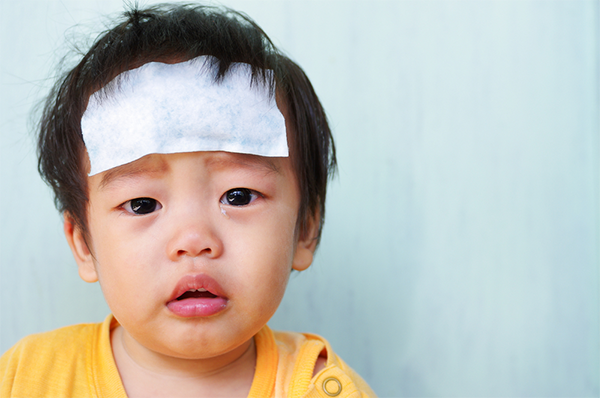
When your little one heats up, knowing the right baby fever treatment can make all the difference. Cool compress, lots of cuddles, and calm confidence.
While most fevers go away on their own, taking proper care of your little one’s fever will make all parties feel better. Here’s how to bring down baby fever:
1. Use fever-reducing medication
For babies over 2 months, paracetamol or acetaminophen is an option, says Dr. Esguerra. Before giving medication, consult your pediatrician, especially for babies under 2 months.
2. Dress baby in lightweight clothing
Skip the fleece onesie and go for breathable cotton. A light blanket is fine if they’re shivering, but don’t pile on layers.
3. Keep the room cool
Set the thermostat around 20°C (68°F) and make sure your baby is comfy. A fan or aircon helps, just ensure that the vents aren’t directed at your baby.
4. Give a tepid sponge bath
Tepid or lukewarm water helps cool the body gently. Sponge their back, arms, and legs, but skip cold water or alcohol rubs, which can backfire.
5. Offer plenty of fluids
Fevers can dehydrate babies quickly. If your little one is under 6 months, stick with breastmilk or formula. For babies over 6 months, you can offer small sips of water or oral rehydration fluids as long as prescribed by a pediatrician. Watch for dry lips, fewer wet diapers, or no tears when crying.
6. Let baby rest
Now’s the perfect time to cuddle with baby. Let them sleep and don’t wake them unless your doctor says to give medicine. Remember, their body heals best during rest!
7. Use baby fever patches
When used as directed, baby fever patches or cooling gel can be a gentle and soothing option to help your little one feel more comfortable.
Note that there are limited studies on the effectiveness of cooling gel among children. However, a 2020 study published in Pediatric Critical Care Medicine, involving children averaging around 4 years old, showed some good results. The group was small (only 16 patients), but the study found that using a special gel pad system effectively managed temperature in critically ill kids who also tolerated it well.
Keep an eye on your little one and check their temperature every few hours. Take note of their appetite, energy, and breathing. If anything feels off, trust your gut and call your doctor immediately.
What Not to Do When Baby Has a Fever
When your baby has a fever, your first instinct is to fix it fast. However, some old-school remedies can do more harm than good. Don’t bundle your baby in layers thinking you’ll “sweat it out”—that might actually trap heat and make the fever worse.
Skip cold baths and alcohol rubs, too. They might sound effective but can cause chills or discomfort. And don’t guess medicine doses or reach for adult meds. If your baby is really young or just seems off, don’t wait it out; call your doctor. A little knowledge and a lot of love go a long way.
Baby fever can feel like a big deal, and sometimes, it is. But in most cases, it’s your baby’s way of fighting off an infection. According to the National Institutes of Health, when parents feel confident and informed, they’re able to comfort and care for their little ones better.
So, breathe easy, mama! Keep the snuggles coming, keep a close eye on your baby and when in doubt, call your pediatrician. You’ve got this, now you know what to do when baby has fever!
References
American Academy of Pediatrics, Infant Fever Overview and Guidelines, (2021). https://www.aap.org/en/patient-care/infant-fever/
HealthyChildren.org (AAP), Fever: When to Call the Pediatrician, (2022) https://www.healthychildren.org/English/health-issues/conditions/fever/Pages/When-to-Call-the-Pediatrician.aspx
Mandal, S., & De, M. S. (2017). Assessing Fever Frequency After Pediatric Live Attenuated Versus Inactivated Influenza Vaccination. Journal of the Pediatric Infectious Diseases Society, 6(3), e7-e14. https://academic.oup.com/jpids/article/6/3/245/2957377
Philippine Pediatric Society (PPS). (2020). Interim Guidelines on the Screening, Assessment, and Clinical Management of Pediatric Patients with Suspected or Confirmed COVID‑19 (which include antipyretic and fever management recommendations for children in the Philippines). Retrieved from https://pps.org.ph/wp-content/uploads/2020/03/pps-pidsp.pdf pps.org.ph+3pps.org.ph+3pps.org.ph+3
Muñoz, F. M., et al. (2023). Fever following routine pediatric vaccinations: Normal or not? Journal of the Pediatric Infectious Diseases Society, 12(1), 5–10. https://doi.org/10.1093/jpids/piad009
Pediatric Infectious Disease Society of the Philippines & Philippine Pediatric Society. (2017). Clinical Practice Guidelines on Dengue in Children (Final version, June 2017). Retrieved from https://www.pidsphil.org/home/wp-content/uploads/2017/06/2017_Dengue_CPG_Final.pdf
Italian Journal of Pediatrics, "Paracetamol and ibuprofen combination for the management of acute mild-to-moderate pain in children," 2023. https://ijponline.biomedcentral.com/articles/10.1186/s13052-023-01445-4
National Institute of Neurological Disorders and Stroke. (2024, November 22). Febrile seizures. In Health Information. https://www.ninds.nih.gov/health-information/disorders/febrile-seizures











